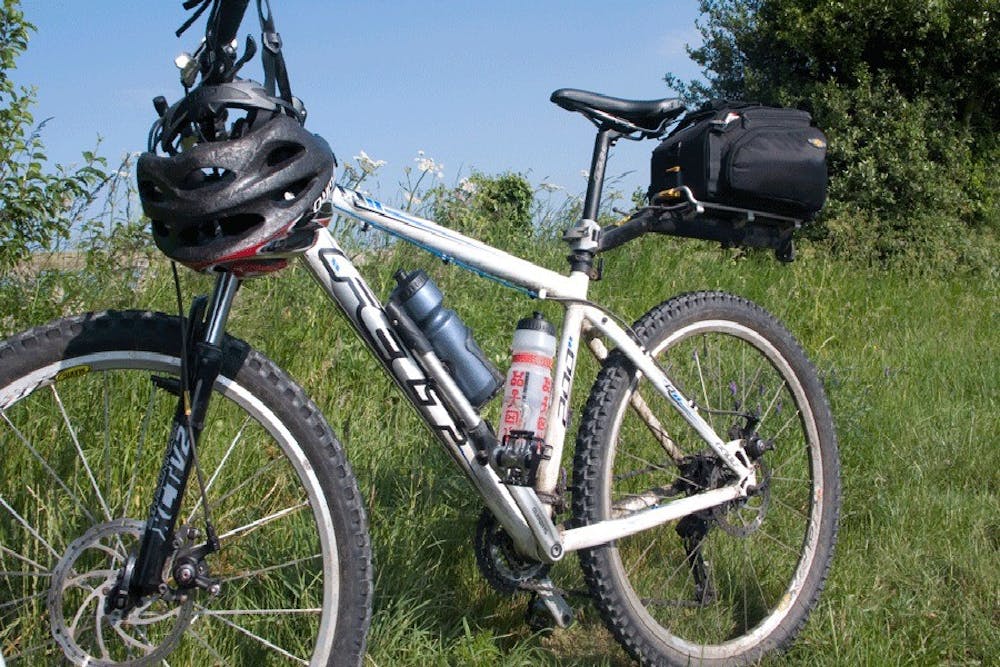By Kate Rousmaniere, rousmak@miamioh.edu
Creative Commons Photo
As the fine fall weather rolls in and Miami's campus comes back to life, there are more and more bicycles on the road. With the brand new designated bike lanes on Spring Street and the multi-use path along Patterson Ave, this is a good moment for everyone to review standard laws for bicyclists and cars.
Bicyclists and cars actually share most traffic rules, which often means sharing a lane. Read on for the full list of safety guidelines to keep in mind this year.
Obey traffic signals
Both cyclists and car drivers must obey traffic signals and stop signs and should ride on the right side of the road. Riding on the left is illegal and dangerous for both cars and bikes.
This holds true for cyclists on the bike lanes who must follow all traffic signals and stop signs-and yes, that even means on the bike lanes on Spring Street. Both bikes and cars can earn a traffic citation by running a stop sign.
Ride on the Road
By Ohio law, bicyclists may ride on sidewalks in certain areas, but it's not a good idea. Accident studies show that even low-speed sidewalk riding has about double the accident rate as riding on the road. The danger increases with speed. If you ride on the sidewalk, every intersection and even every driveway is a potential collision site. Motorists crossing your path do not look for conflicting traffic on the sidewalk, especially if you are coming from the "wrong way." Bicyclists are prohibited from riding on sidewalks in the Oxford Uptown area.
Turns
The rules for turns are exactly the same for bicycles as for other vehicles: merge to the appropriate position (right for right turns, left for left turns), yield to any traffic that has the right of way and then turn. For cyclists, getting into position for a left turn may involve merging across lanes of traffic. If traffic is heavy, cyclists should start doing this early to take advantage of gaps in traffic: make sure you are visible to all cars as you move into the turning lane; use hand signals indicating your turn; try to get eye contact with drivers of cars. Beginning cyclists may want to make pedestrian-style turns instead by dismounting and walking the bicycle through the intersection
Like car drivers, bicyclists should never turn or change lanes without first yielding to any traffic that has the right of way, and give a signal if possible.
In addition to legal guidelines, cyclists should follow general best practices.
Bike Lanes
A bicycle lane is a designated traffic lane for bicyclists, and only bicyclists are permitted on that lane. No moving or parked cars are permitted on bike lanes.
Bicyclists must ride in the bike lane only in the same direction as other traffic. Riding against the flow of traffic is against the law and greatly increases your chances of having a crash, especially at intersections where pedestrians and crossing traffic are unlikely to see you.
Safety Tips for Bikes
1. Be safe. Wear a bike helmet!
2. Be predictable: make your intentions clear to motorists and other road users. Ride in a straight line and don't swerve between parked cars. Signal turns, and check behind you well before turning or changing lanes.
3. Be Visible: ride where drivers can see you and wear bright clothing. When riding in the dark or twilight, cyclists should always use both a headlight and blinking taillight. Many cyclists also use a blinking taillight in the daytime. Lights, reflectors, and bright colored biking shirts and tunics are available at any bike shop.
4. Anticipate: consider what drivers, pedestrians, and other bicyclists will do next. Watch for turning vehicles and ride outside the door zone of parked cars. Look out for debris, potholes, and utility covers. Cross railroad tracks at right angles.
Safety Tips for Cars
1. When driving on a road with a bike lanes, keep your eyes out for cyclists who might be turning at an intersection onto a road without a bike lane.
2. Pay attention to the "sharrows" signal on the road, which, like the "share the road" signs, means that bikes will be on the road.
3. Move to the center of the road when passing a cyclist.
4. Don't honk at a cyclist as it could scare the cyclist into a fall. If you want to gain a cyclist's attention, tap your horn lightly.
5. After parking your car, look carefully in your rearview mirror before opening your car door so that you do not injure a passing cyclist.
6. Drivers might consider turning their head lights on, to make it easier for cyclists to see you coming, both ahead and in their rearview mirrors.
For more information, see the League of American Bicyclists for additional information. www.bikeleague.org/ and the Ohio Bicycle Federation www.ohiobike.org/
In addition, the Ohio Department of Transportation provides a number of helpful handbooks on smart bicycling, Ohio bikeways, information about biking to work, and funding opportunities for local governments and private citizens to encourage, educate, and design pedestrian and bicycle facilities. www.dot.state.oh.us/bike.
Oxford's local bicycle shop, Bike Wise, located at 9 North Beech St. http://bikewiseoxford.com/ 523-4880, sells new and used bikes and a lot of bike safety equipment including helmets and lights.
Share the road!
Kate Rousmaniere is a professor in the Department of Educational Leadership, an elected member of the Oxford City Council, and a bike enthusiast.

